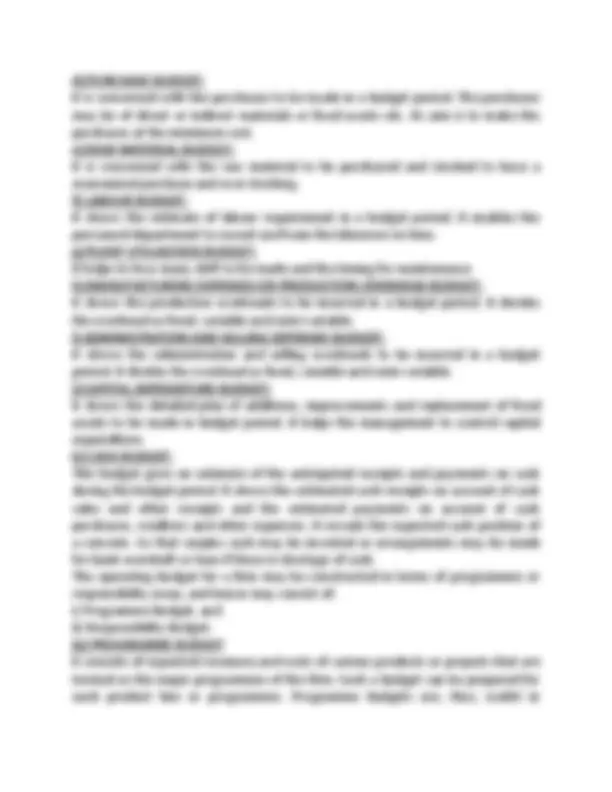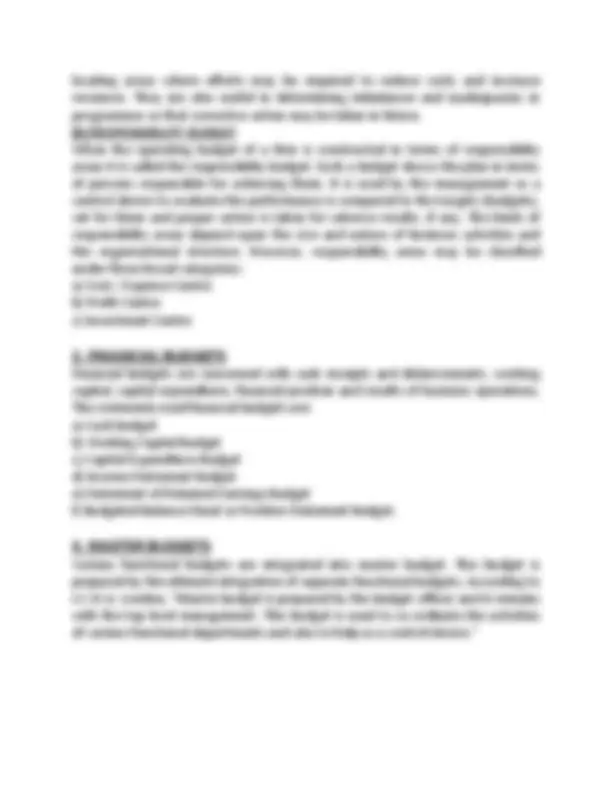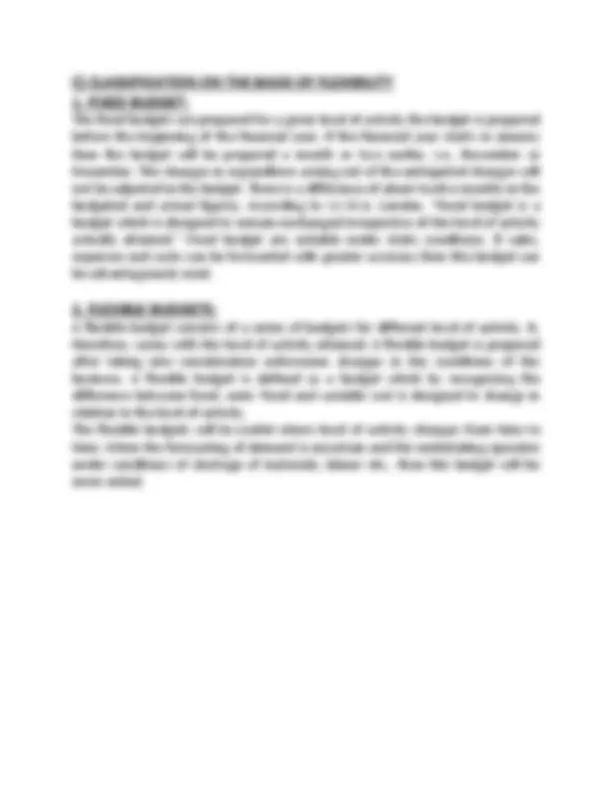





Study with the several resources on Docsity

Earn points by helping other students or get them with a premium plan


Prepare for your exams
Study with the several resources on Docsity

Earn points to download
Earn points by helping other students or get them with a premium plan
Community
Ask the community for help and clear up your study doubts
Discover the best universities in your country according to Docsity users
Free resources
Download our free guides on studying techniques, anxiety management strategies, and thesis advice from Docsity tutors
CLASSIFICATION AND TYPES OF BUDGETS
Typology: Lecture notes
1 / 5

This page cannot be seen from the preview
Don't miss anything!




The budgets are usually classified according to their nature. The following are the types of budgets, which are commonly used. A) Classification According to Time
**1. Long-term budgets.
The budgets are prepared to depict long term planning of the business. The period of long term budgets varies between five to ten years. The long term planning is done by the top level management; it is not generally known to lower levels of management. Long-time budgets are prepared for some sectors of the concern such as capital expenditure, research and development, long-term finances etc. These budgets are useful for those industries where gestation period is long i.e., machinery, electricity, engineering, etc.
2. SHORT-TERM BUDGETS These budgets are generally for one or two years and are in the form of monetary terms. The consumer’s goods industries like sugar, cotton, textile, etc. use short- term budgets. 3. CURRENT BUDGETS The period of current budgets is generally of months and weeks, these budgets relate to the current activities of the business. According to I.C.W.A. London. “Current budget, which is established for use over a short period of time, is related to current conditions.”
These budgets relate to the different activities or operations of a firm. The number of such budgets depends upon the size and nature of business. The commonly used operating budgets are: a) Sales Budget: b) Production Budget: c) Production Cost Budget: d) Purchase Budget: e) Raw Material Budget: f) Labour Budget: g) Plant utilization Budget: h) Manufacturing Expenses or Production Overhead Budget: i) Administration and selling Expenses Budget: j) Capital Expenditure Budget: k) Cash Budget. a) SALES BUDGET: Sales budget is a forecast of sales to be made in a given period. It is the responsibility of the sales manager to prepare a sales budget after taking into account the past sales market conditions and the efforts made to promote sales. In this budget, the break up figures may be given in respect of the following:
locating areas where efforts may be required to reduce costs and increase revenues. They are also useful in determining imbalances and inadequacies in programmes so that corrective action may be taken in future. (b) RESPONSIBILITY BUDGET When the operating budget of a firm is constructed in terms of responsibility areas it is called the responsibility budget. Such a budget shows the plan in terms of persons responsible for achieving them. It is used by the management as a control device to evaluate the performance is compared to the targets (budgets), set for them and proper action is taken for adverse results, if any. The kinds of responsibility areas depend upon the size and nature of business activities and the organisational structure. However, responsibility areas may be classified under three broad categories: a) Cost / Expense Centre b) Profit Centre c) Investment Centre
Financial budgets are concerned with cash receipts and disbursements, working capital, capital expenditure, financial position and results of business operations. The commonly used financial budgets are: a) Cash Budget b) Working Capital Budget c) Capital Expenditure Budget d) Income Statement Budget e) Statement of Retained Earnings Budget f) Budgeted Balance Sheet or Position Statement Budget.
Various functional budgets are integrated into master budget. This budget is prepared by the ultimate integration of separate functional budgets. According to I.C.W.A. London, “Master budget is prepared by the budget officer and it remains with the top level management. This budget is used to co-ordinate the activities of various functional departments and also to help as a control device.”
The fixed budgets are prepared for a given level of activity the budget is prepared before the beginning of the financial year. If the financial year starts in January then the budget will be prepared a month or two earlier, i.e., November or December. The changes in expenditure arising out of the anticipated changes will not be adjusted in the budget. There is a difference of about twelve months in the budgeted and actual figures. According to I.C.W.A. London, “Fixed budget is a budget which is designed to remain unchanged irrespective of the level of activity actually attained.” Fixed budget are suitable under static conditions. If sales, expenses and costs can be forecasted with greater accuracy then this budget can be advantageously used.
A flexible budget consists of a series of budgets for different level of activity. It, therefore, varies with the level of activity attained. A flexible budget is prepared after taking into consideration unforeseen changes in the conditions of the business. A flexible budget is defined as a budget which by recognizing the difference between fixed, semi- fixed and variable cost is designed to change in relation to the level of activity. The flexible budgets will be useful where level of activity changes from time to time. When the forecasting of demand is uncertain and the undertaking operates under conditions of shortage of materials, labour etc., then this budget will be more suited.